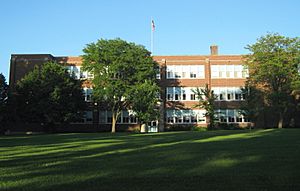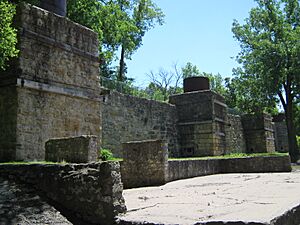Maquoketa, Iowa facts for kids
Quick facts for kids
Maquoketa, Iowa
|
|
|---|---|

Maquoketa Middle School
|
|
| Nickname(s):
Timber City
|
|
| Motto(s):
One of a Kind
|
|

Location of Maquoketa, Iowa
|
|
| Country | |
| State | |
| Counties | Jackson |
| Incorporated | January 27, 1857 |
| Area | |
| • Total | 4.54 sq mi (11.76 km2) |
| • Land | 4.52 sq mi (11.70 km2) |
| • Water | 0.03 sq mi (0.07 km2) |
| Elevation | 702 ft (214 m) |
| Population
(2020)
|
|
| • Total | 6,128 |
| • Density | 1,356.65/sq mi (523.78/km2) |
| Time zone | UTC-6 (Central (CST)) |
| • Summer (DST) | UTC-5 (CDT) |
| ZIP code |
52060
|
| Area code(s) | 563 |
| FIPS code | 19-49215 |
| GNIS feature ID | 0458789 |
Maquoketa (pronounced m-uh-KOH-kuh-tuh) is a city in Jackson County, Iowa, United States. It sits right on the Maquoketa River. This city is the county seat of Jackson County, meaning it's where the county government is located.
U.S. Route 61 runs next to Maquoketa. This road connects Dubuque and the Quad Cities. Other Iowa highways, 62 and 64, also go through the city. A cool place called Maquoketa Caves State Park is just a few miles northwest.
In 2020, about 6,128 people lived in Maquoketa.
Contents
History of Maquoketa
Early Settlement and Naming
The first settler in the Maquoketa area was John E. Goodenow. He arrived in 1838 and built his home. This was near where Main and Platt streets are today. By 1840, more settlers like Zalmon Livermore and Alonzo Spaulding joined him.
This early settlement was first called Springfield. It grew quickly for two main reasons. First, it was on the mail and stagecoach route from Davenport to Dubuque. Second, it was on the path for pioneers traveling from Chicago to the west. The area also had plenty of water from the Maquoketa River. This helped new businesses grow.
Around 1840, the mail route officially went through Springfield. John Goodenow became the postmaster. In 1844, the town's name changed to Maquoketa. This was because there were too many towns named Springfield. The name Maquoketa comes from the Meskwaki word Maquaw-Autaw, meaning "Bear River."
As other nearby towns became smaller, Maquoketa grew into the main business center. In 1843, settlers started dividing their land. This led to the unique street layout you see today. In 1849, John Goodenow built the Goodenow House. This was the town's first hotel. It brought more visitors and showed Maquoketa's potential.
Growth and Challenges
The Davenport and St. Paul Railroad reached Maquoketa in 1870. This helped the town grow even more. In 1873, Maquoketa became the county seat. Before that, Andrew held that title.
Maquoketa saw a lot of economic growth in the late 1800s. This was because of its natural resources. There was plenty of timber, limestone, and good farmland. As the town became richer, people built large, fancy homes. Many of these beautiful houses are still standing today.
World War I started in 1917. This war greatly affected businesses in Maquoketa. Many young men left their jobs to join the military. When the war ended in 1918, soldiers returned home. They were welcomed with parades on Main Street.
The Great Depression hit in 1929. This caused construction to stop in the business area. The American Savings Bank closed down. Its building was updated in 1935. A grocery store opened on the first floor. The American Legion used the upstairs for meetings. Maquoketa was not as badly affected as some other places. This was likely because it was on two important highways.
After World War II, Maquoketa grew even more. Many new homes were built, especially on the west side. These houses were often built on old farmland. This growth helped the town's success after the war.
In 1950, Maquoketa built its first public hospital. Before this, the town had smaller private hospitals. The new public hospital helped provide better healthcare for everyone.
Also in 1950, the Clinton Machine Company moved to Maquoketa. Don Thomas led this move. The company built a large factory on 12 acres. It used a train track for easy transportation. Clinton Engines, a part of the company, became very big. It made about 18 million small engines. It was one of the largest employers in Iowa.
Modern Changes and Revitalization
In the 1960s, a new business area started to appear. Main Street used to be part of US Highway 61. But a new four-lane highway bypass was planned. Many businesses on Main Street decided to move. They went to the west side of town. They wanted to be closer to the new highway traffic.
The Highway 61 bypass opened in 1967. After that, more businesses moved away from Main Street. Even with these changes, building owners kept their properties in good shape.
The 1980s were tough for many towns in Jackson County. A farm crisis hurt rural communities. Maquoketa's population only dropped a little. But the farm crisis still affected local farm businesses. It created some economic uncertainty.
In 1999, a new four-lane Highway Sixty-One bypassed the town again. This moved even more traffic away from downtown. It hurt local businesses that relied on people passing through. Maquoketa became less visible and harder to reach. But the town kept trying to find new ways to grow.
The early 2000s brought more challenges. Downtown Maquoketa already had empty stores. Then, the Clinton Engines Company closed. The worst event was a big fire on January 19, 2008. It destroyed a large part of the downtown area. This was a sad event, but it also led to new efforts. People started working to make downtown better.
Starting in the 2010s, Maquoketa began to bounce back. New businesses came to town. There were big investments in roads and other important services. The city also focused on saving its historic downtown.
A new hospital was built in 2019. This improved healthcare for everyone. Maquoketa also started building new housing areas. This helped meet the need for more homes.
Demographics
| Historical population | |||
|---|---|---|---|
| Census | Pop. | %± | |
| 1850 | 168 | — | |
| 1860 | 1,090 | 548.8% | |
| 1870 | 1,756 | 61.1% | |
| 1880 | 2,467 | 40.5% | |
| 1890 | 3,077 | 24.7% | |
| 1900 | 3,777 | 22.7% | |
| 1910 | 3,570 | −5.5% | |
| 1920 | 3,626 | 1.6% | |
| 1930 | 3,595 | −0.9% | |
| 1940 | 4,076 | 13.4% | |
| 1950 | 4,307 | 5.7% | |
| 1960 | 5,909 | 37.2% | |
| 1970 | 5,677 | −3.9% | |
| 1980 | 6,313 | 11.2% | |
| 1990 | 6,130 | −2.9% | |
| 2000 | 6,112 | −0.3% | |
| 2010 | 6,141 | 0.5% | |
| 2020 | 6,128 | −0.2% | |
| Iowa Data Center | |||
2020 Census Data
In 2020, the city had 6,128 people. There were 2,674 households. The population density was about 1,357 people per square mile. Most residents (90.6%) were White. About 1.7% of the population was Hispanic or Latino. The average age in the city was 41.3 years old.
2010 Census Data
In 2010, Maquoketa had 6,141 people. There were 2,655 households. The population density was about 1,418 people per square mile. Most people (95%) were White. About 1.8% of the population was Hispanic or Latino. The average age was 41 years old.
Geography
Maquoketa is located at 42°4′1″N 90°39′58″W. It is mostly in Jackson County.
The city covers a total area of about 4.37 square miles. Of this, about 4.33 square miles is land. The rest, about 0.04 square miles, is water.
Climate in Maquoketa
| Climate data for Maquoketa, Iowa, 1991–2020 normals, extremes 1896–present | |||||||||||||
|---|---|---|---|---|---|---|---|---|---|---|---|---|---|
| Month | Jan | Feb | Mar | Apr | May | Jun | Jul | Aug | Sep | Oct | Nov | Dec | Year |
| Record high °F (°C) | 62 (17) |
71 (22) |
85 (29) |
93 (34) |
105 (41) |
104 (40) |
108 (42) |
108 (42) |
102 (39) |
94 (34) |
80 (27) |
68 (20) |
108 (42) |
| Mean maximum °F (°C) | 48.0 (8.9) |
52.9 (11.6) |
68.0 (20.0) |
80.1 (26.7) |
87.7 (30.9) |
91.7 (33.2) |
92.4 (33.6) |
90.7 (32.6) |
89.1 (31.7) |
83.4 (28.6) |
66.8 (19.3) |
52.4 (11.3) |
94.1 (34.5) |
| Mean daily maximum °F (°C) | 26.7 (−2.9) |
31.2 (−0.4) |
44.5 (6.9) |
58.6 (14.8) |
70.3 (21.3) |
79.4 (26.3) |
82.2 (27.9) |
80.6 (27.0) |
74.8 (23.8) |
61.7 (16.5) |
46.1 (7.8) |
32.5 (0.3) |
57.4 (14.1) |
| Daily mean °F (°C) | 19.0 (−7.2) |
23.1 (−4.9) |
35.5 (1.9) |
47.8 (8.8) |
59.8 (15.4) |
69.6 (20.9) |
72.5 (22.5) |
70.6 (21.4) |
63.2 (17.3) |
50.7 (10.4) |
37.2 (2.9) |
25.3 (−3.7) |
47.9 (8.8) |
| Mean daily minimum °F (°C) | 11.4 (−11.4) |
15.1 (−9.4) |
26.4 (−3.1) |
37.0 (2.8) |
49.3 (9.6) |
59.8 (15.4) |
62.9 (17.2) |
60.6 (15.9) |
51.6 (10.9) |
39.8 (4.3) |
28.3 (−2.1) |
18.0 (−7.8) |
38.4 (3.5) |
| Mean minimum °F (°C) | −13.4 (−25.2) |
−7.6 (−22.0) |
4.4 (−15.3) |
22.1 (−5.5) |
33.2 (0.7) |
45.9 (7.7) |
51.0 (10.6) |
49.6 (9.8) |
36.1 (2.3) |
23.6 (−4.7) |
11.1 (−11.6) |
−3.9 (−19.9) |
−17.5 (−27.5) |
| Record low °F (°C) | −37 (−38) |
−34 (−37) |
−21 (−29) |
5 (−15) |
21 (−6) |
33 (1) |
39 (4) |
34 (1) |
17 (−8) |
2 (−17) |
−8 (−22) |
−27 (−33) |
−37 (−38) |
| Average precipitation inches (mm) | 1.32 (34) |
1.65 (42) |
2.22 (56) |
3.44 (87) |
4.21 (107) |
5.09 (129) |
4.15 (105) |
4.18 (106) |
3.64 (92) |
2.93 (74) |
2.08 (53) |
1.78 (45) |
36.69 (930) |
| Average snowfall inches (cm) | 8.4 (21) |
8.0 (20) |
3.8 (9.7) |
0.9 (2.3) |
0.1 (0.25) |
0.0 (0.0) |
0.0 (0.0) |
0.0 (0.0) |
0.0 (0.0) |
0.3 (0.76) |
1.7 (4.3) |
7.1 (18) |
30.3 (76.31) |
| Average precipitation days (≥ 0.01 in) | 7.3 | 7.3 | 8.8 | 10.9 | 11.9 | 11.3 | 9.4 | 8.9 | 8.4 | 9.2 | 7.3 | 8.6 | 109.3 |
| Average snowy days (≥ 0.1 in) | 5.6 | 4.9 | 2.7 | 0.6 | 0.0 | 0.0 | 0.0 | 0.0 | 0.0 | 0.2 | 1.3 | 5.4 | 20.7 |
| Source 1: NOAA | |||||||||||||
| Source 2: National Weather Service | |||||||||||||
Education in Maquoketa
Public Schools
The Maquoketa Community School District runs the public schools. They work with the community to educate students.
- Maquoketa High School: This school is home to the Cardinals. It has about 620 students in grades 9 through 12. More than 50 teachers and staff work there.
- Maquoketa Middle School: This is the oldest school building in Maquoketa. It was built in 1922 after the old one burned down. It used to be a junior high, high school, and junior college. Today, it has about 375 students in grades 6 through 8. Over 60 teachers and staff work at the middle school.
- Briggs Elementary School: Built in 1954, this school is named after Ansel Briggs. He was the first Governor of Iowa and an early settler. It has about 300 students in grades 3 through 5. There are 35 teachers and staff.
- Cardinal Elementary School: This school was built in 1974. It started with grades 1 through 6. In 2002, it changed to teach only kindergarten through 2nd grade. It has 37 teachers and staff.
Private Schools
- Sacred Heart Elementary School: This is a Catholic school. It teaches students from preschool up to sixth grade. It has 132 students and 20 staff members.
Preschools
- The Little Shepherd Preschool: This preschool is located in the First Lutheran Church of Maquoketa.
- Sunshine Preschool and Daycare: This is a nonprofit organization that started in 1973. It accepts children from 6 months to 12 years old. This includes children with disabilities. Currently, it has 145 children and 30 staff.
College
Clinton Community College has a campus in Maquoketa. It's right next to Maquoketa High School. The building opened in 2009 and is 11,000 square feet. It offers associate degrees and special training. High school students can also take classes there to help with their education.
Attractions in Maquoketa
- Maquoketa Caves State Park: A great place to explore caves and nature.
- Hurstville Lime Kilns: Old kilns used to make lime, located north of Maquoketa.
- Jackson County Iowa Historical Society: Learn about the history of Jackson County.
- Clinton Engines Museum: Discover the history of the famous Clinton Engines.
- 61 Drive-in theater: Enjoy movies outdoors at this classic drive-in.
- Camp Shalom Inc.: A camp for outdoor activities and fun.
- Historic Downtown: The town has a historic district. It features many beautiful examples of Victorian architecture.
Maquoketa is also a popular stop for presidential candidates. For example, Barack Obama visited the town twice during his 2008 campaign. He also returned as president in 2011.
The Old City Hall Gallery displays oil paintings by Rose Frantzen. She is a famous artist from Maquoketa. Her exhibit "Portrait of Maquoketa" showed paintings of 180 local residents. It was once displayed at the Smithsonian National Portrait Gallery in Washington, DC. Now, you can see it at the Figge Art Museum in Davenport, Iowa.
Notable People from Maquoketa
- Archie Atherton, a famous parachutist
- Norris Brown, a Senator from Nebraska
- Craig Callahan, a professional basketball player
- James H. Cartwright, an Illinois Supreme Court justice
- Betty Francis, a player in the All-American Girls Professional Baseball League
- John Elliot Goodenow, a politician and the town's founder
- Herbert E. Hitchcock, a Senator from South Dakota
- Alfred Hurst, a politician and businessman
- Charles Wycliffe Joiner, a US federal judge
- Matthew Luckiesh, a physicist
- Junius Ralph Magee, a former Methodist bishop
- Eben Martin, a former US Representative
- Robert A. Millikan, a Nobel Prize winner
- Joseph Otting, a businessman and former Comptroller of the Currency
- Sage Rosenfels, a former quarterback in the NFL
- George Homer Ryan, a former Governor of Illinois
- William Welch, who started printing high school diplomas
See also
 In Spanish: Maquoketa (Iowa) para niños
In Spanish: Maquoketa (Iowa) para niños



